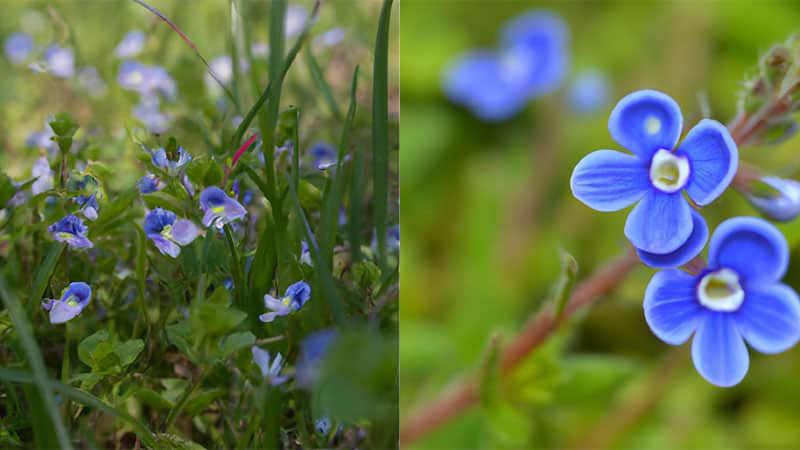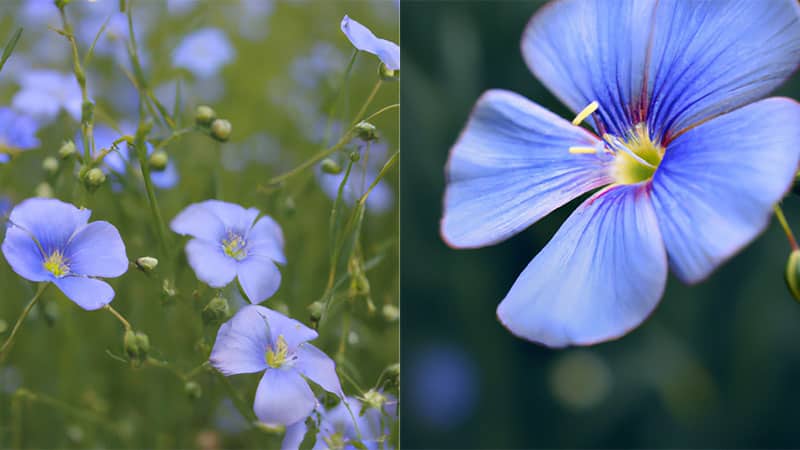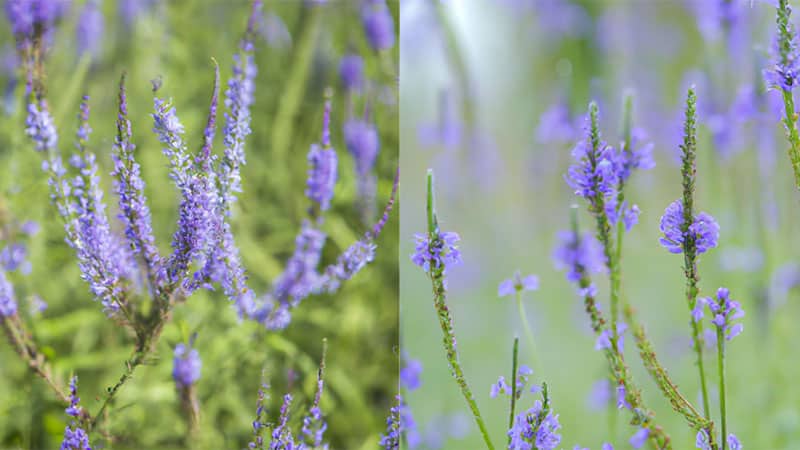A healthy and vibrant lawn is a common goal for homeowners and gardeners alike. One of the difficulties they frequently face is the presence of weeds with blue flowers, which can diminish the overall attractiveness of the landscape. This problem will be addressed by providing information on identifying and controlling these specific types of weeds. Understanding the characteristics of these weeds and implementing effective prevention and control strategies will provide you with the knowledge required to maintain a weed-free and visually appealing lawn.

- Identifying Weeds with Blue Flowers
- 1. Chicory (Cichorium intybus):
- 2. Speedwell (Veronica spp.):
- 3. Spiderwort (Tradescantia spp.):
- 4. Creeping Bellflower (Campanula rapunculoides):
- 5. Forget-Me-Not (Myosotis spp.):
- 6. Ground Ivy (Glechoma hederacea):
- 7. Blueweed (Echium vulgare):
- 8. Blue Star Creeper (Laurentia fluviatilis):
- 9. Blue Flax (Linum perenne):
- 10. Blue-Eyed Grass (Sisyrinchium spp.):
- 11. Bachelor’s Button (Centaurea cyanus):
- 12. Blue Vervain (Verbena hastata):
- 13. Blue Curls (Trichostema dichotomum):
- 14. Blue Woodruff (Asperula orientalis):
- 15. Blue Lettuce (Lactuca biennis):
- Tips for Correctly Identifying These Weeds
- Reasons for the Presence of Weeds with Blue Flowers
- Controlling Weeds with Blue Flowers in Lawns
- Maintaining a Weed-Free Lawn
- Conclusion
Identifying Weeds with Blue Flowers
It is critical to identify weeds with blue flowers in lawns for effective control and management. Several common types of weeds have blue-colored flowers, and correctly identifying them is the first step towards resolving the problem. Here are some examples of weeds with blue flowers commonly found in lawns:
1. Chicory (Cichorium intybus):

Chicory features delicate blue flowers with a daisy-like appearance. Its leaves are deeply lobed and have a jagged edge. Chicory plants can grow tall and may have a taproot.
2. Speedwell (Veronica spp.):

Speedwell displays small, vibrant blue flowers on slender stalks. The leaves are typically oval or lance-shaped and arranged opposite each other along the stem. Some speedwell species also have creeping stems.
3. Spiderwort (Tradescantia spp.):

Spiderwort produces clusters of blue or purple flowers. The leaves are long and grass-like, often exhibiting a smooth or hairy texture. Spiderwort plants are known for their unique three-petaled flowers.
4. Creeping Bellflower (Campanula rapunculoides):

Creeping bellflower showcases bell-shaped blue flowers on upright stalks. Its heart-shaped leaves are toothed along the edges. This weed spreads through underground rhizomes, making it difficult to control.
5. Forget-Me-Not (Myosotis spp.):

Forget-me-not features small, delicate blue flowers with yellow centers. The leaves are typically oval-shaped and covered with tiny hairs. Forget-me-not plants are known for their ability to self-seed and quickly spread.
6. Ground Ivy (Glechoma hederacea):

Ground ivy, also known as creeping Charlie, displays small, tubular blue-violet flowers. Its leaves are round or kidney-shaped with scalloped edges and have a distinctive minty aroma when crushed. Ground ivy spreads quickly, forming dense mats in lawns.
7. Blueweed (Echium vulgare):

Blueweed features tall spikes of vibrant blue flowers. The leaves are lance-shaped and covered with rough hairs. Blueweed is an invasive weed that can quickly take over disturbed areas of lawns and gardens.
8. Blue Star Creeper (Laurentia fluviatilis):

Blue star creeper produces star-shaped blue flowers that form a dense ground cover. The leaves are small, oval, and bright green. It is often used as a low-growing plant in rock gardens but can become weedy in lawns if not properly managed.
9. Blue Flax (Linum perenne):

Blue flax showcases delicate sky-blue flowers on slender stems. Its leaves are narrow and linear, giving the plant a grass-like appearance. Blue flax is commonly cultivated for its ornamental value but can escape cultivation and become a weed in lawns.
10. Blue-Eyed Grass (Sisyrinchium spp.):

Blue-eyed grass features small, iris-like blue flowers with yellow centers. Despite its name, it is not a true grass but rather a member of the iris family. The leaves are long and slender, resembling grass blades.
11. Bachelor’s Button (Centaurea cyanus):

Bachelor’s button, also known as cornflower, displays distinctive blue flowers with a prominent central disk. The leaves are lance-shaped and covered with fine hairs. While it is cultivated as an annual ornamental plant, it can self-seed and become weedy in lawns.
12. Blue Vervain (Verbena hastata):

Blue vervain produces tall spikes of tiny blue-purple flowers. The leaves are lance-shaped and toothed along the edges. Blue vervain is a native perennial weed that can establish itself in lawns and other disturbed areas.
13. Blue Curls (Trichostema dichotomum):

Blue curls exhibit unique tubular blue flowers with curled petals. The leaves are narrow and arranged opposite each other along the stem. Blue curls often thrive in dry, sandy soils and can become weedy in lawns.
14. Blue Woodruff (Asperula orientalis):

Blue woodruff features clusters of small, star-shaped blue flowers. The leaves are narrow and whorled around the stem, giving the plant a distinctive appearance. Blue woodruff can spread aggressively through self-seeding.
15. Blue Lettuce (Lactuca biennis):

Blue lettuce produces small blue flowers in clusters at the top of tall stems. The leaves are deeply lobed and have a bluish-green hue. It is considered a biennial weed and can be found in open areas, including lawns, fields, and roadsides.
It is critical to correctly identify these weeds with blue flowers in order to implement targeted control measures. Take note of the flower colour, shape, and size, as well as the characteristics of the leaves and stems, when inspecting these plants. If you’re unsure about an identification, consult field guides or reliable online resources, or seek professional help. Following that, we’ll look at how to correctly identify these weeds and tell them apart from other plant species in your lawn.
Tips for Correctly Identifying These Weeds
Due to the diversity of plant species and their similar characteristics, identifying weeds with blue flowers in lawns can be difficult at times. Here are some tips to help you correctly identify these weeds:
- Examine the flowers: Pay close attention to the color, shape, and size of the flowers. Look for unique features such as tubular shapes, star-like petals, or clustered blooms. Note the overall appearance and any distinguishing characteristics.
- Observe the leaves: Study the leaves of the plant. Take note of their shape, arrangement, and texture. Look for specific leaf patterns, such as lobed, lance-shaped, narrow, or grass-like. Pay attention to any unique features such as serrated edges, fine hairs, or distinct veining.
- Analyze the stem: Examine the stem of the weed. Notice its height, thickness, and texture. Some weeds may have square or round stems, while others may be woody or herbaceous. Stem characteristics can provide valuable clues for identification.
- Consult reliable resources: Utilize field guides, weed identification books, or reputable online resources specifically focused on identifying weeds with blue flowers. These resources often provide detailed descriptions, photographs, and helpful identification keys to assist you in accurately identifying the weeds.
- Seek professional help: If you are uncertain about the identification or unable to find a match using available resources, consider reaching out to a professional horticulturist, botanist, or a local extension service. They have expertise in plant identification and can provide guidance based on their knowledge and experience.
- Document and compare: Take clear photographs or collect samples of the weeds you are trying to identify. Compare them to reference images or descriptions to help in the identification process. Keeping a record of the identified weeds can also be helpful for future reference.
Remember that accurate identification is essential for weed control. Because different weeds may necessitate different management strategies, accurate identification is critical in order to select the most appropriate control methods. You can improve your ability to identify weeds with blue flowers in your lawn and take targeted action to control them by following these tips and using reliable resources.















Reasons for the Presence of Weeds with Blue Flowers
The presence of weeds with blue flowers in lawns can be attributed to various factors. Understanding these reasons can help homeowners and gardeners devise effective strategies to prevent and control their growth. Here are some common reasons for the presence of weeds with blue flowers:
- Soil conditions: Weeds with blue flowers often thrive in specific soil conditions. Some of these plants prefer acidic soils, while others may favor compacted or poorly drained soils. Understanding the soil conditions in your lawn can provide insights into why certain weeds with blue flowers are prevalent.
- Lack of proper lawn care: Insufficient or improper lawn care practices can create favorable conditions for weeds with blue flowers to flourish. Inadequate watering, poor mowing techniques, and improper fertilization can weaken the grass, allowing opportunistic weeds to take root and thrive.
- Neglected lawn edges: Neglected lawn edges provide an ideal environment for weeds to establish and spread. Weeds with blue flowers can easily infiltrate and colonize these areas, encroaching on the lawn. Regular maintenance of lawn edges is essential to prevent the proliferation of these weeds.
- Seed dispersal: Weeds with blue flowers often produce large quantities of seeds that can be dispersed by wind, animals, or human activities. The seeds can travel long distances and find their way into lawns, germinating and growing into mature plants. Understanding the seed dispersal mechanisms of these weeds can help in devising effective prevention measures.
- Invasive characteristics: Some weeds with blue flowers possess invasive characteristics, rapidly spreading and outcompeting desirable plants in the lawn. Their aggressive growth habits and ability to reproduce quickly make them challenging to control once established.
- Environmental conditions: Environmental factors such as temperature, light availability, and moisture levels can influence the growth and proliferation of weeds with blue flowers. Some of these plants may thrive in shady areas, while others prefer open, sunny locations. Understanding the specific environmental preferences of these weeds can aid in their control.
- Introduction of contaminated soil or seeds: Weeds with blue flowers can be introduced into lawns through contaminated soil or contaminated seeds used for landscaping or gardening purposes. These unwanted plants can then establish themselves and spread within the lawn.
Homeowners and gardeners can prevent the growth of weeds with blue flowers in their lawns by understanding the causes of their presence. Implementing proper lawn care practises, addressing soil issues, and monitoring and maintaining lawn edges on a regular basis are critical steps in preventing the establishment and spread of these weeds. Furthermore, understanding seed dispersal mechanisms and invasive characteristics can help guide the selection of appropriate control methods.
Controlling Weeds with Blue Flowers in Lawns
Controlling weeds with blue flowers in lawns is essential to sustaining a healthy and aesthetically pleasing yard. Here are effective strategies and methods to help you manage these unwanted plants:
- Regular mowing: Maintain a regular mowing schedule and keep your grass at the appropriate height. Regular mowing helps to prevent weeds from flowering and producing seeds. Adjust your mower to remove only one-third of the grass blade, as this promotes a dense and healthy lawn that can outcompete weeds.
- Hand-pulling: For isolated or small infestations, hand-pulling can be an effective method of weed control. Make sure to get dispose of the entire plant, including the roots, to prevent regrowth. It is recommended to pull weeds when the soil is moist, as it makes it easier to extract entire plants.
- Mulching: Apply an organic mulch layer, such as wood chips or straw, around plants and in garden beds to suppress weed growth. Mulch acts as a physical barrier, preventing sunlight from reaching weed seeds and inhibiting their germination. Make sure to maintain an adequate thickness of mulch to maximize its weed control benefits.
- Herbicides: Selective herbicides specifically formulated for broadleaf weed control can be effective in managing weeds with blue flowers. These herbicides target broadleaf weeds while sparing desirable grass species. Follow the manufacturer’s instructions carefully when using herbicides, and consider spot-treating affected areas rather than applying them to the entire lawn.
- Cultural practices: Implement proper cultural practices to promote a healthy lawn that can naturally outcompete weeds. This includes regular watering, appropriate fertilization, and proper soil management. Healthy, well-maintained lawns are less susceptible to weed infestations.
- Manual cultivation: Use a hand trowel or weed digger to remove stubborn weeds with blue flowers that are deeply rooted. Dig around the plant, loosening the soil, and carefully remove the entire root system. Be cautious not to disturb the surrounding grass or desirable plants.
- Preventive measures: To prevent the spread of weed seeds, promptly remove spent flowers before they have a chance to produce seeds. Additionally, practice good sanitation by cleaning garden tools and equipment to avoid introducing weed seeds into different areas of your lawn.
- Professional assistance: If weed infestations are extensive or persistent, consider seeking professional help from a lawn care service or a qualified horticulturist. They can provide expert advice, identify specific weed species, and recommend targeted control methods.
When using herbicides or chemical control methods, always follow the manufacturer’s instructions and safety precautions. Integrated pest management (IPM) techniques, which combine multiple control strategies, can often produce the best long-term weed management results.
You can effectively manage and control weeds with blue flowers in your lawn by combining these control strategies and maintaining proper lawn care practices. Maintaining a weed-free and beautiful lawn requires consistency, attention to detail, and regular monitoring.
Maintaining a Weed-Free Lawn
Maintaining a weed-free lawn requires ongoing effort and a proactive approach. Here are essential tips and practices to help you achieve and sustain a weed-free environment:
- Healthy lawn care practices: Promote the health and vigor of your lawn to prevent weed growth. Follow these practices:
- Proper mowing: Set your mower blade to the recommended height for your grass type and avoid cutting it too short, as this weakens the grass and allows weeds to invade.
- Regular watering: Water deeply and infrequently to encourage deep root growth in your grass. Avoid overwatering, as it can create favorable conditions for weed growth.
- Correct fertilization: Apply the appropriate type and amount of fertilizer based on your lawn’s needs. Over-fertilizing can stimulate excessive weed growth, so follow the recommended application rates.
- Reseeding and overseeding: Fill in bare patches in your lawn by reseeding or overseeding. A thick, dense turf reduces space for weed establishment and growth. Choose grass varieties that are well-suited for your region and can outcompete weeds.
- Aerate your lawn: Regularly aerate your lawn to alleviate soil compaction. This improves water and nutrient penetration, promoting healthier grass growth and reducing weed competition.
- Weed prevention barriers: Install physical barriers, such as landscape fabric or plastic mulch, around garden beds and borders to prevent weed seeds from infiltrating your lawn.
- Regular maintenance of lawn edges: Pay close attention to lawn edges and keep them well-maintained. Regularly edge along sidewalks, driveways, and garden beds to prevent encroachment by weeds.
- Practice good sanitation: To prevent weeds, dispose of lawn clippings, leaves, and other plant debris. Clean garden tools and equipment after each use to avoid unintentionally introducing weed seeds to other areas.
- Monitor for early signs of weeds: Regularly inspect your lawn for the emergence of weeds, especially those with blue flowers. Early detection allows for prompt action and prevents weeds from establishing and spreading.
- Hand weeding: Continuously monitor and hand-pull weeds as soon as they appear. Be thorough in removing the entire plant, including roots, to prevent regrowth.
- Mulch garden beds: Apply organic mulch like wood chips or shredded bark to garden beds and around trees and shrubs. This suppresses weed growth and helps retain soil moisture.
- Follow an integrated approach: Combine various weed control strategies, including cultural practices, manual weeding, mulching, and selective herbicide use, as part of an integrated approach. This maximizes effectiveness and minimizes reliance on a single control method.
- Regular lawn inspections: Regularly walk your lawn and inspect it for any signs of weed growth. Promptly address any emerging weeds to prevent them from spreading.
- Stay informed: Stay up to date with lawn care practices, new weed control techniques, and plant identification. Educate yourself on the specific weeds common in your region to better understand their life cycles and implement targeted control measures.
By consistently implementing these practices and remaining vigilant, you can keep your lawn weed-free and enjoy a healthy, vibrant outdoor space. The keys to achieving and preserving a beautiful, weed-free environment are regular maintenance, good cultural practices, and timely weed control measures.
Conclusion
Maintaining a weed-free lawn necessitates perseverance, consistency, and a combination of preventive and proactive weed control strategies. Weeds with blue flowers can be especially difficult to control, but with the right knowledge and practices, you can effectively prevent their growth and keep your lawn looking beautiful. You can enjoy a lush, weed-free environment by implementing proper lawn care practices, identifying and addressing your lawn’s specific needs, and remaining vigilant in weed detection and control. Remember to use an integrated approach that combines cultural practices, manual weeding, mulching, and selective herbicide use as needed. You can achieve and maintain a weed-free lawn with dedication and a proactive mindset.
